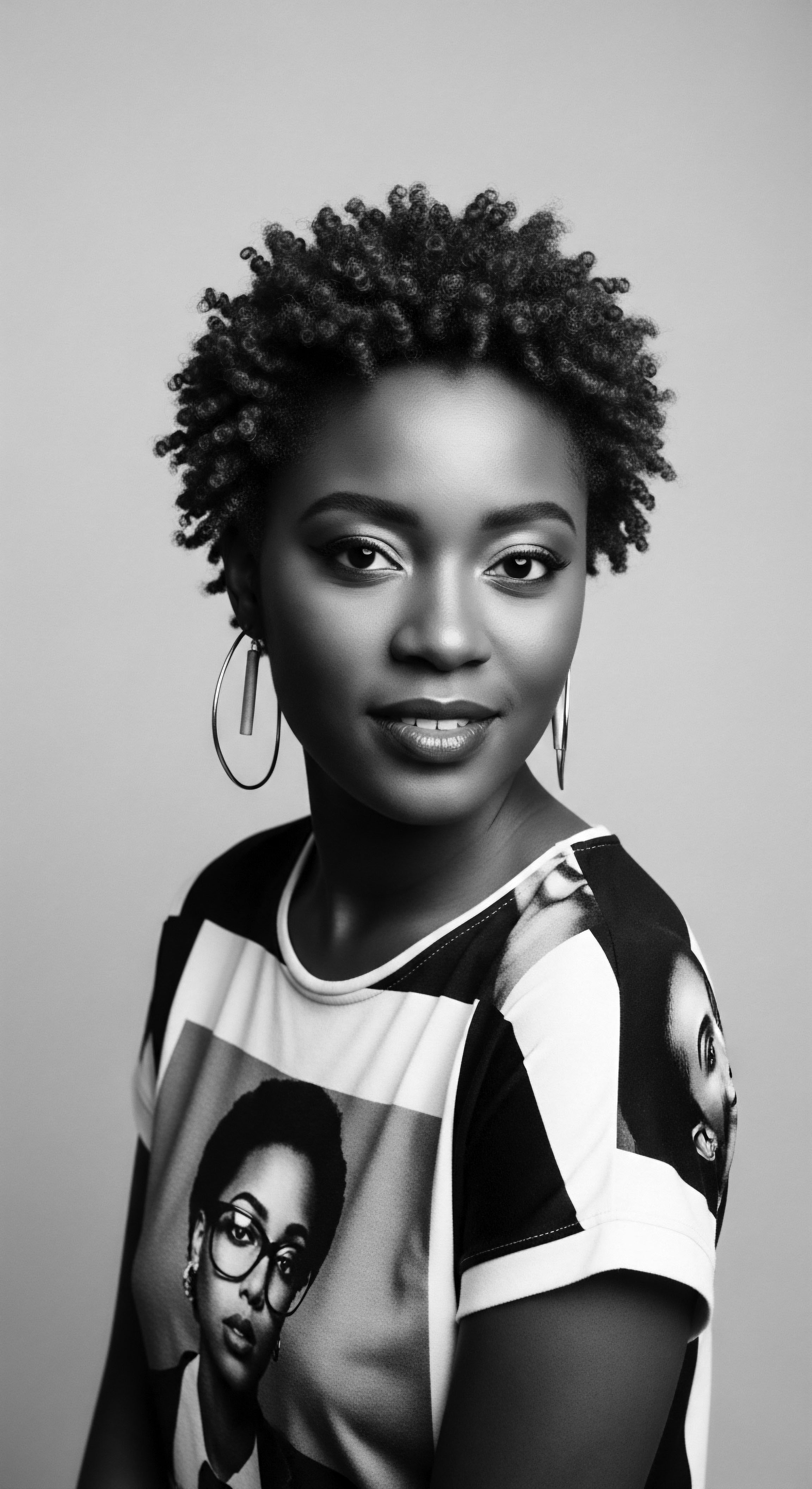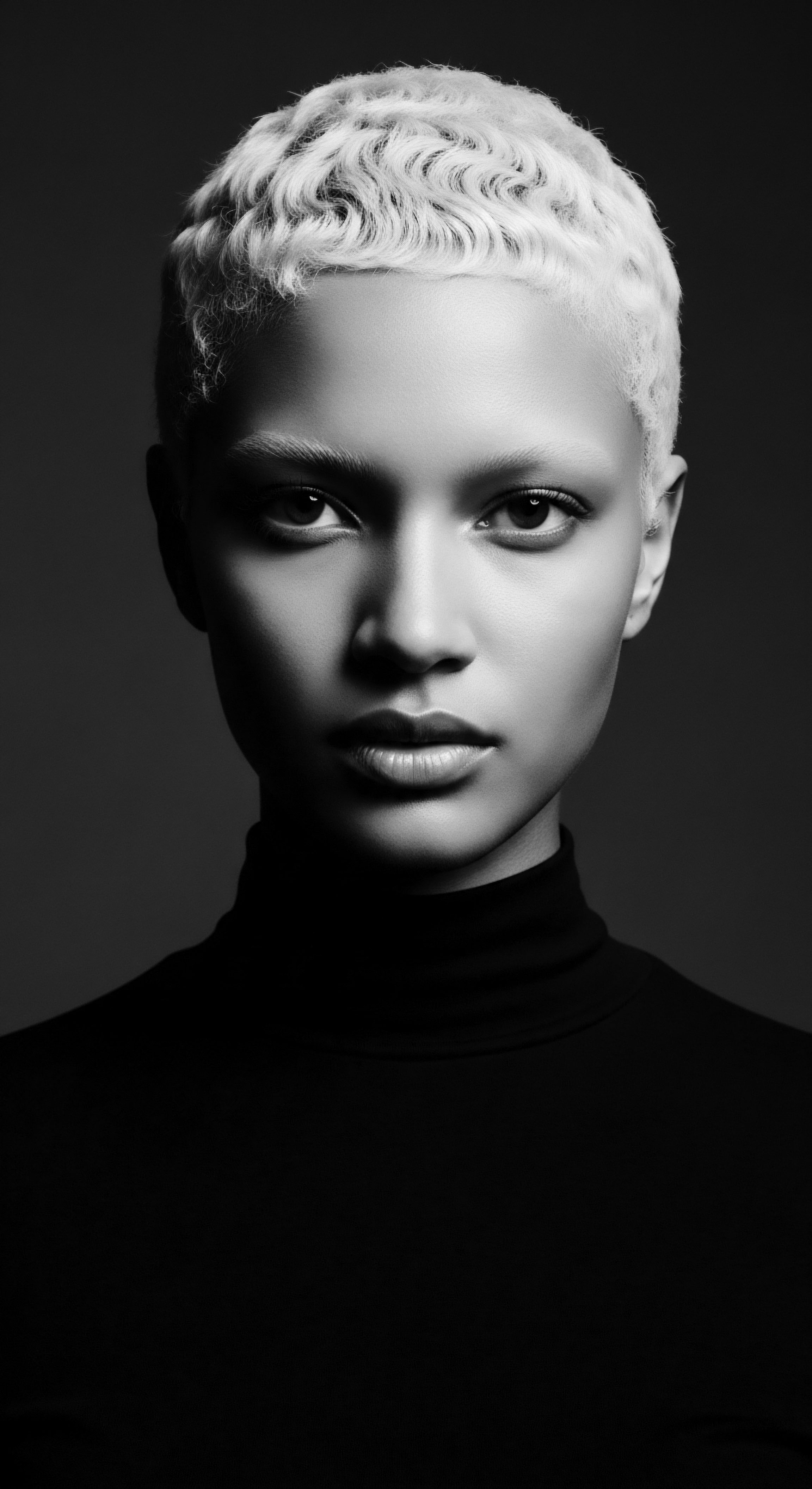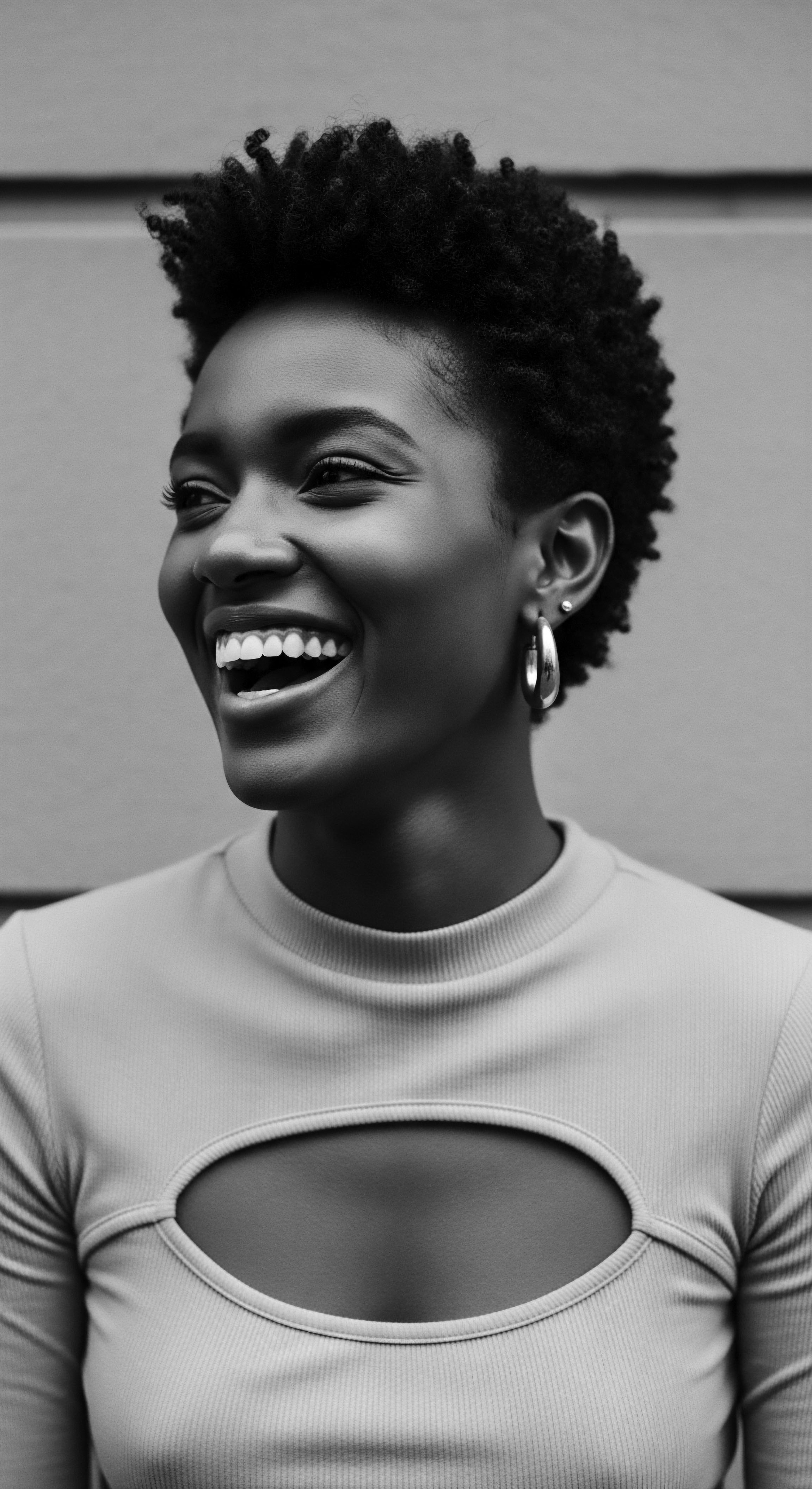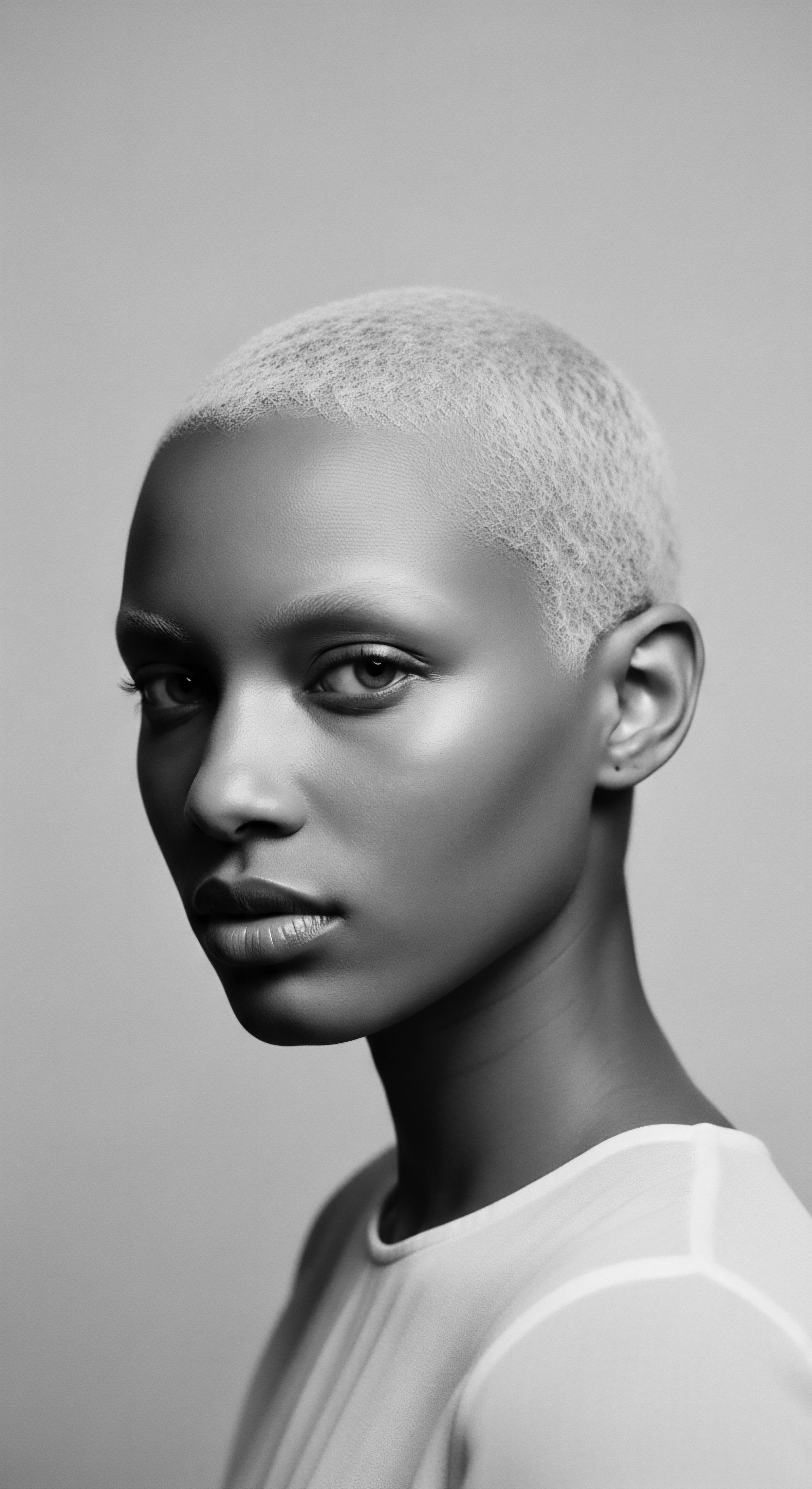
Roots
There is a profound, whispering lineage woven into the very structure of textured hair—a language spoken not in words, but in the helical twists of keratin and the stories etched into ancient styling tools. It is a chronicle of resistance, of ingenuity, of unyielding beauty, echoing from the sun-drenched savannas to the vibrant diasporic communities worldwide. Understanding textured hair, then, becomes more than mere scientific inquiry; it transforms into a sacred act of tracing an ancestral current, a recognition that within each curl and coil resides a living archive of identity and resilience. This enduring connection to our past, held within the very fibers of our being, shapes how we perceive ourselves and the world around us.

The Architecture of Ancestral Hair
The distinctive qualities of textured hair begin at its source, deep within the scalp. Unlike straight hair, which emerges from a round follicle, textured hair typically originates from an elliptical or oval follicle . This shape dictates the hair strand’s trajectory, causing it to grow in a curvilinear path. The protein bonds within the hair shaft, particularly disulfide bonds, are distributed unevenly, leading to a natural propensity to curl or coil.
This inherent structural quality, a biological marvel, gives rise to a spectrum of curl patterns, from gentle waves to tightly wound coils, each a testament to nature’s boundless creativity. For millennia, indigenous peoples understood these fundamental characteristics not through microscopes but through intimate observation, passed down through generations. They observed how hair behaved, how it responded to moisture, to dry air, to different plant-based preparations. This observation birthed practices that honored the hair’s natural inclination.
Textured hair’s unique biological structure, shaped by elliptical follicles and uneven protein bonds, forms a living testament to ancestral heritage.
Consider the earliest insights into hair. Before the advent of modern microscopy, knowledge of hair’s inherent characteristics—its tendency to shrink, to resist breakage when kept moisturized, its varied densities—was accumulated through diligent practice and communal wisdom. This formed a kind of folk hair science , deeply connected to specific environments and available natural resources.
For instance, in West Africa, the climate often demands styles and care that protect hair from arid conditions, leading to the prevalence of braided or twisted forms that retain moisture and minimize exposure (Byrd & Tharps, 2014). This adaptation is not merely practical; it binds the very physics of hair to the cultural narratives of survival and adaptation.

How Does Biology Inform Ancestral Hair Traditions?
The biology of textured hair, with its inherent tendency towards dryness due to the open cuticle layers at the curves of the strand, directly influenced ancient care rituals. Oils, butters, and humectants—derived from local plants and animals—were not random choices; they were intentional responses to the hair’s needs. Shea butter, for example, a staple across many African communities, provided a rich emollient that coated the hair, sealing in moisture and protecting it from environmental stressors.
Similarly, the practice of braiding or twisting offered not only stylistic versatility but also acted as a physical barrier against dust, sun, and tangling, preserving the integrity of the fragile strands. This deep, intuitive understanding of hair’s anatomy, gained through generations of lived experience, formed the foundation of care that resonates even today.
The classification of textured hair, particularly in contemporary contexts, often uses numerical or alphabetical systems (e.g. 3C, 4A) to describe curl patterns. While these systems aim for clarity, they can sometimes oversimplify the vast spectrum of textures and overlook the cultural context embedded in hair diversity. Historically, classifications were often more fluid, tied to identity, marital status, age, or tribal affiliation.
A woman’s hair might denote her readiness for marriage, a warrior’s dreadlocks his spiritual devotion. These traditional understandings of hair’s diversity were not about a numeric code but about its meaning within a collective story.
| Hair Characteristic Dryness Tendency |
| Ancestral Observation Hair benefits from regular oiling and sealing; moisture loss evident in arid climates. |
| Modern Scientific Link Open cuticle layers at curl bends allow moisture escape. |
| Hair Characteristic Shrinkage |
| Ancestral Observation Hair appears shorter when wet or after washing, then extends when stretched or styled. |
| Modern Scientific Link Coiled structure allows for significant contraction and elongation. |
| Hair Characteristic Fragility at Bends |
| Ancestral Observation Areas where hair bends tightly seem more prone to breakage if not handled gently. |
| Modern Scientific Link Stress points along the curve of the strand can be weaker. |
| Hair Characteristic The enduring wisdom of ancestral hair care often intuitively matched modern scientific findings regarding textured hair. |

Ritual
From the fundamental understanding of hair’s biology, human ingenuity unfolded into an expansive realm of styling—a realm where artistry and heritage converge. The adornment of textured hair has always reached beyond mere aesthetics; it is a profound declaration, a visible chronicle of a people’s journey. Each twist, braid, and coil speaks of belonging, of resistance, of celebration.
These practices, handed down through generations, are not static historical relics. They are living, breathing rituals that shape and are shaped by the contemporary spirit.

The Enduring Power of Protective Styling
Protective styles stand as perhaps the most enduring testament to this deep connection between hair and identity. Long before their contemporary resurgence, styles such as braids , twists , and locs served multifaceted roles across African societies. Beyond their obvious function of safeguarding delicate strands from environmental damage and reducing tangles, they functioned as complex systems of communication. A particular braiding pattern could signify a person’s marital status, age, religious beliefs, or even their village of origin (Tharps & Byrd, 2015).
For instance, specific cornrow patterns among the Yoruba people of Nigeria communicated social standing or readiness for war. These were not simply hairstyles; they were visual dialects, integral to social fabric and personal narrative.
Consider the intricate braiding traditions that traveled across the Atlantic during the transatlantic slave trade. Hair braiding became a covert map, a means of storing seeds, or a silent act of resistance against cultural erasure. This historical context imprints an undeniable significance upon every braid today, making it a symbol of survival and defiant beauty.
Even the simple act of parting hair in a certain way could be loaded with meaning, as seen in various West African cultures where a central part might signify balance or connection to the divine. This rich layer of meaning elevates styling from routine to ritual, grounding it in collective memory.
Styling textured hair extends beyond aesthetics, acting as a profound historical and cultural declaration.

How Do Ancient Tools Speak to Styling Heritage?
The tools used for styling textured hair possess their own ancestral echo. Before the widespread availability of modern combs and styling implements, materials found in nature were ingeniously repurposed. Wooden combs , often intricately carved, served not only to detangle and section hair but were sometimes considered spiritual objects, passed down through families. Bone, ivory, and natural fibers were shaped into instruments that facilitated braiding, twisting, and coiling.
These tools, sometimes adorned with cowrie shells or symbolic carvings, further entwined the act of hair care with broader cultural beliefs and practices. Their continued existence in museums and private collections reminds us of the profound respect afforded to the hair and its preparation within these communities.
The evolution of styling techniques for textured hair also reflects a continuous dialogue between tradition and innovation. From the meticulously crafted, culturally specific head-wraps of diverse African ethnic groups to the elaborate hairstyles of historical figures like Queen Nefertiti, the principles of protection, adornment, and communication remained central. These ancient forms inform countless contemporary styles, creating a visual unbroken line from past to present.
- Cornrows ❉ Ancient braiding technique, roots in Africa, signifying status, identity, or used to convey messages.
- Locs ❉ Varied historical and spiritual significance across cultures, from ancient Egypt to contemporary Rasta communities.
- Bantu Knots ❉ Traditional South African style, used for curl definition or as a protective measure.

Relay
The daily act of caring for textured hair is a continuous conversation with our ancestors, a living transmission of wisdom passed through generations. It is here, in the tender ministrations of cleansing, moisturizing, and protecting, that the heritage of textured hair truly comes alive. This regimen is not merely a set of instructions; it is a philosophy, a way of understanding oneself through the prism of ancestral practices and natural harmony. It represents a deeper knowledge, often validated by contemporary science, illustrating how tradition and innovation can coexist, each enriching the other.

The Nighttime Sanctuary ❉ Ancestral Protection and Bonnet Wisdom
Among the most significant and often understated rituals of textured hair care is the nighttime routine, particularly the practice of protecting hair while sleeping. The use of bonnets, scarves, and headwraps for sleep protection has deep historical roots, long preceding modern hair care industry developments. Across various African and diasporic cultures, covering the hair at night was a commonplace practice for both men and women. This custom primarily served a practical purpose ❉ safeguarding elaborate hairstyles, preventing tangles, and preserving moisture.
Hair, particularly when styled in intricate patterns or left loose, can become dry, frizzy, or matted during sleep due to friction with cotton pillowcases. The soft, smooth surfaces of silk or satin, materials valued for their gentle qualities, became intuitively understood as superior for hair protection.
Beyond the practical, there was also a cultural and spiritual significance. Head coverings, in many African societies, carried meanings of modesty, reverence, and beauty (Sieber & Herreman, 2000). To cover the hair at night was also an extension of self-respect and careful stewardship of one’s appearance and spiritual being.
The modern satin bonnet, ubiquitous in many Black households today, directly descends from these ancestral practices, acting as a silent, continuous thread connecting present-day care to a rich, enduring heritage. It embodies a wisdom about hair preservation that has been relayed across continents and centuries.
Nighttime hair protection, especially with satin or silk coverings, holds deep ancestral roots, preserving both hair integrity and cultural reverence.
The holistic approach to textured hair care, deeply influenced by ancestral wellness philosophies, views hair health as intrinsically linked to overall well-being. This perspective encourages consideration of diet, hydration, stress levels, and even emotional states as contributing factors to hair vitality. Ancient healers and community elders often prescribed herbal remedies for both internal health and external application to hair, recognizing the interconnectedness of the body. For instance, the use of fenugreek for hair growth in parts of North Africa and India, or chebe powder from Chad for length retention, reflects generations of observation and practical knowledge, demonstrating a systemic approach to wellness that incorporates external application with internal balance.

What Traditional Ingredients Speak to Hair Heritage?
A deep understanding of traditional ingredients forms the core of ancestral hair care and provides valuable lessons for contemporary regimens. These ingredients, often sourced locally and sustainably, offered potent benefits, meticulously observed and passed down.
- Shea Butter ❉ A rich emollient from the shea tree, widely used across West Africa for its moisturizing and protective qualities, particularly for dry skin and hair. Its history extends back to ancient Egypt.
- Coconut Oil ❉ A staple in many tropical regions, valued for its ability to penetrate the hair shaft, reducing protein loss, and providing shine (Rele & Mohile, 2003). Its use is documented in Ayurvedic and traditional African practices.
- Aloe Vera ❉ Known for its soothing and moisturizing properties, used historically in various cultures for scalp health and conditioning.
- Rhassoul Clay ❉ A mineral-rich clay from Morocco, historically used for cleansing hair and scalp without stripping natural oils.
- Hibiscus ❉ Flowers and leaves used in traditional Indian and African hair remedies to stimulate growth and add luster.
Problem-solving in textured hair care has also benefited from this continuum of heritage. Ancestral communities, facing environmental challenges or specific hair ailments, devised ingenious solutions. For tangled hair, careful finger-detangling or using wide-toothed wooden combs after applying oils was a common practice, minimizing breakage. For scalp issues, infusions of specific herbs or cleansing clays were applied, drawing on deep botanical knowledge.
Modern hair science, in many instances, confirms the efficacy of these methods, reinforcing the profound wisdom embedded in historical practices. The challenge of maintaining length, for example, which is often difficult due to shrinkage and breakage, was addressed by low-manipulation styles and rich conditioning treatments, strategies that continue to serve as cornerstones of healthy hair journeys today.

Reflection
Textured hair, in its myriad forms, stands as a vibrant, living testament to enduring cultural identity. It carries within its very structure the echoes of ancient drumbeats, the whispers of ancestral prayers, and the defiant resilience of a people who have navigated immense historical currents. This journey, from the elemental biology of the strand to the communal rituals of care and the profound declarations of self, is a continuous story. Each coil, each kink, each wave is a brushstroke on a canvas of collective memory, a tangible link to those who came before us, and a beacon for those who will follow.
The Soul of a Strand ethos recognizes that textured hair is far more than a biological phenomenon; it is a repository of heritage, a library of wisdom, and a living celebration of who we are. Its enduring presence, despite centuries of systemic pressures, speaks volumes of its inherent power and its inseparable connection to the spirit of a people. As we continue to learn, to care, and to celebrate, we are not simply tending to hair; we are honoring a legacy, writing new chapters in a story that began at the dawn of time, ensuring that the profound narrative of textured hair continues to unfold with power and grace.

References
- Byrd, A. D. & Tharps, L. L. (2014). Hair Story ❉ Untangling the Roots of Black Hair in America. St. Martin’s Press.
- Rele, V. G. & Mohile, R. B. (2003). Effect of mineral oil, sunflower oil, and coconut oil on prevention of hair damage. Journal of Cosmetic Science, 54(2), 175-192.
- Sieber, R. & Herreman, M. (2000). Hair in African Art and Culture. The Museum for African Art.
- Tharps, L. L. & Byrd, A. D. (2015). Hair Story ❉ Untangling the Roots of Black Hair in America (Updated Edition). St. Martin’s Press.
